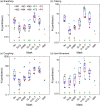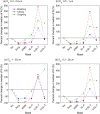Efficacy of masks and face coverings in controlling outward aerosol particle emission from expiratory activities
- PMID: 32973285
- PMCID: PMC7518250
- DOI: 10.1038/s41598-020-72798-7
Efficacy of masks and face coverings in controlling outward aerosol particle emission from expiratory activities
Abstract
The COVID-19 pandemic triggered a surge in demand for facemasks to protect against disease transmission. In response to shortages, many public health authorities have recommended homemade masks as acceptable alternatives to surgical masks and N95 respirators. Although mask wearing is intended, in part, to protect others from exhaled, virus-containing particles, few studies have examined particle emission by mask-wearers into the surrounding air. Here, we measured outward emissions of micron-scale aerosol particles by healthy humans performing various expiratory activities while wearing different types of medical-grade or homemade masks. Both surgical masks and unvented KN95 respirators, even without fit-testing, reduce the outward particle emission rates by 90% and 74% on average during speaking and coughing, respectively, compared to wearing no mask, corroborating their effectiveness at reducing outward emission. These masks similarly decreased the outward particle emission of a coughing superemitter, who for unclear reasons emitted up to two orders of magnitude more expiratory particles via coughing than average. In contrast, shedding of non-expiratory micron-scale particulates from friable cellulosic fibers in homemade cotton-fabric masks confounded explicit determination of their efficacy at reducing expiratory particle emission. Audio analysis of the speech and coughing intensity confirmed that people speak more loudly, but do not cough more loudly, when wearing a mask. Further work is needed to establish the efficacy of cloth masks at blocking expiratory particles for speech and coughing at varied intensity and to assess whether virus-contaminated fabrics can generate aerosolized fomites, but the results strongly corroborate the efficacy of medical-grade masks and highlight the importance of regular washing of homemade masks.
Conflict of interest statement
The authors declare no competing interests.
Figures






References
-
- Bourouiba L. Turbulent gas clouds and respiratory pathogen emissions: potential implications for reducing transmission of COVID-19. JAMA. 2020;323:1837–1838. - PubMed

